Exquisite Brioche Recipe
Rediscover a superior quality pastry.
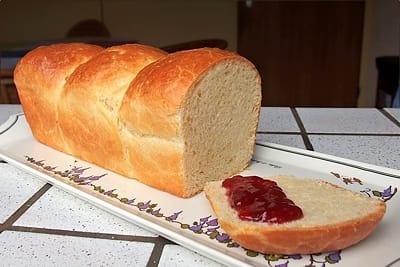
Brioche
This brioche is rich in flavour, with a distinct taste of butter and bakery, with a tight and supple texture and a soft crumb. The dough is prepared the day before and its rising is very slow. Spread with a good jam, it will delight your breakfasts and snacks with greediness and pleasure. The brioche is excellent and of superior quality. Guaranteed success among gourmets. Everything is detailed so that you succeed on the first try.
Ingredients for a 24 cm cake tin, about 16 slices:
- 250 g organic wheat flour T65 type (more taste)
- 160 g quality butter with taste, and tender at 15°,
- 150 g eggs (3 medium eggs, beat them a little, weigh them, use the rest for egg wash),
- 30 g blond cane sugar to be ground into icing sugar (about 45 seconds in a blender/chopper),
- 25 g milk (optional) for a milder taste, ideal with flavours (orange blossom, zest…),
- 12 g fresh yeast or 4 to 5 g of dry yeast (or the quantity required for 250 g of flour),
- 3 g (1 teaspoon) salt.
- Glazing: milk for colour or, to give more crispness, mix a beaten egg (for crispness) with a pinch of salt (for the shine).
- Icing (optional): for a sweet note, mix 10 g of sugar with 5 g of water (or simply real maple syrup), heat at 50°, immediately after removing from the oven, spread with a very light and superficial brush on the hot brioche and immediately put it back in the hot oven at 160° for 1 to 2 minutes.
You can garnish the brioche with coarse-grained sugar lumps that will partially dissolve during baking, or add 180 g of raisins moistened for half an hour in hot water, or the zest of an orange, or 15 to 30 ml (1 to 2 tablespoons) of orange blossom water.
Course of the recipe:
The ingredients are at room temperature between 18 and 22°: flour, sugar, eggs. Remove the butter 1/2 at 1 hour from the refrigerator, cut into pieces of 25 g, it must be tender (between 15 and 18°) but not soft (above 20°). Temperature control is important to ensure the right texture of the dough. If the room temperature exceeds 22°, place the ingredients in the refrigerator for a few hours, use cold eggs and butter at 15°.
There are 3 fermentations: the first one after mixing at room temperature for 3 to 5 hours (the dough must start to double in volume, then the dough is pressed to degas it), the second one overnight in the refrigerator and the third one for 2 to 3 hours in the mould. The more you ferment, the more the dough will develop aromas.
In a bowl, first mix the flour, icing sugar and salt. Then crumble the fresh yeast and add it to the dry ingredients. Add the eggs in one go (and some milk if you prefer) and knead for 8 to 10 minutes at low speed with the mixer or food processor to obtain a dense and tight dough.
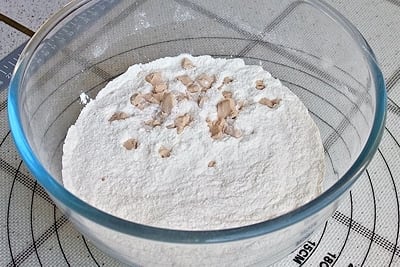

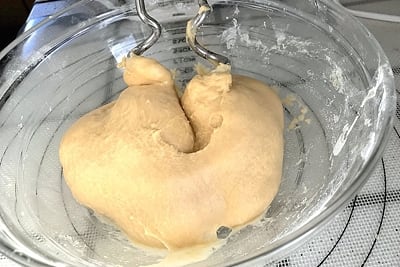
Then add the soft butter as you go along, 25 g by 25 g, and knead at medium speed for about 1 minute between each addition of butter. In total, the kneading will last 15 to 20 minutes or more. The dough will change texture from semi-fluid to thicker as it gains strength. It should become very elastic, smooth in appearance, with a supple and uniform texture, peeling away from the edge of the bowl without tearing. Stop kneading. If the dough has difficulty taking on structure and remains more or less viscous, it is too liquid either because there are too many eggs or the butter starts to melt. You will adjust the texture the next day when shaping the brioche by flouring the dough more generously.
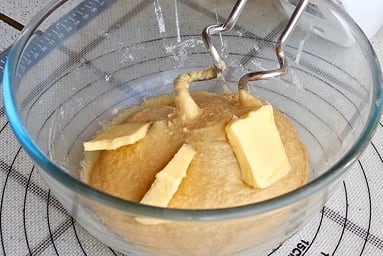

Form a ball with the dough, place a plastic wrap or damp cloth over the bowl and let the dough leaven for 3 to 5 hours at room temperature. Then degas the dough by pressing it well in your hands, make a ball of dough and cover the bowl again with plastic wrap or a damp cloth. Allow to rest overnight in the refrigerator.
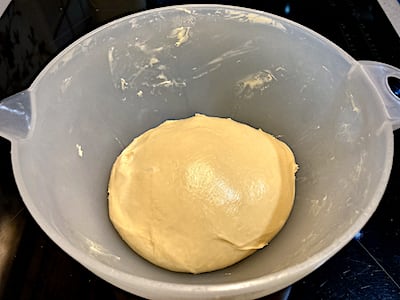
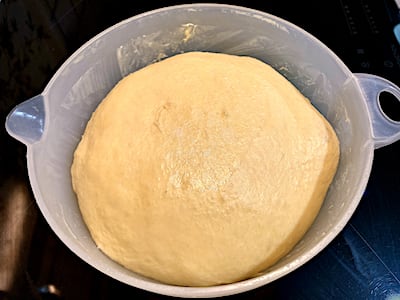
The next day, degas the cold, hard dough with your hands. Flour the worktop. To form the brioche in a cake tin, divide the dough into 3 equal parts, giving the shape of a square, fold the 4 sides in the centre of the square, fold the other 4 sides in the centre again, tighten the junction, turn the folded dough over with the junction underneath, tighten the bottom part of the ball with the edge of your hands to shape a tight and smooth ball. This way, the leaven will be uniform. Alternatively, you can form braids, make small buns in muffin tins or create other decorations if the texture of the dough allows it. A very cold dough makes it easier to handle. If necessary, butter and flour the mould, otherwise there is no need to grease the non-sticky moulds because there is enough butter in the dough.
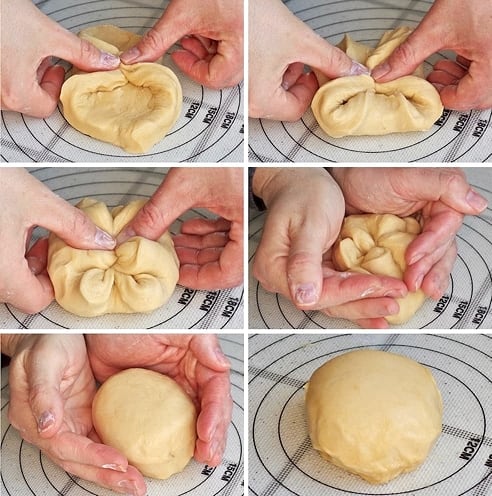
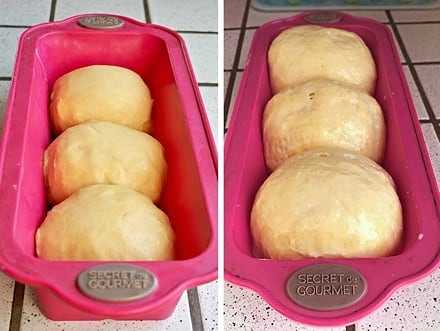
Then let the brioches leaven a third time for 2 to 4 hours in the mould at room temperature between 20 and 24°. It should double in volume, but not more. After the first hour of rising, glaze (egg wash) the brioche once and a second time before moving it into the oven.
For the whole brioche in a cake tin: baking at 150°, with a fan-assisted oven for 35 to 40 minutes, or in a convection oven for 40 to 45 minutes.
For small buns in muffin tins: bake at 160°, with a fan-assisted oven for 15 to 20 minutes, or in a convection oven for 20 to 25 minutes.
Whatever shape you choose, the brioche is best cooked with a light to light brown crust and a crumb that is barely moist and richer in flavour.

As an alternative, and depending on your tastes, you can add a sweet and shiny touch to the brioche with icing. Immediately after taking it out of the oven, apply with a brush a single layer of sugar syrup icing to the brioche, quickly and without insisting.
Let it cool on a wire rack for about 1 to 2 hours. Like many pastries, the brioche can be kept no longer than 12 hours in the open air and eaten the same day. It can be kept for 24 hours in the refrigerator in a paper bag (to absorb moisture) placed in another plastic bag (to prevent evaporation) to maintain a suitable atmosphere (same effect with bread). It keeps very well in the freezer for one month in a bag to stay fresh.
“If-” you'll be a Man…
Re-discover Rudyard Kipling's famous poem “If- you'll be a Man, my son” which has inspired so many generations. It celebrates the courage to overcome hardship.
I've decided to succeed
I have put together 10 tried and tested tips for finding the will to successfully achieve your ambitions and overcome obstacles in your personal and professional life.
Gourmet treats
Exquisite recipes for mini-cakes (madeleines, financiers, biscuits, cakes, muffins) and other delicacies (croissants, brioche, traditional cakes…).